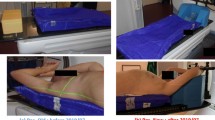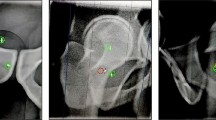Abstract
Purpose: Image-guidance allows for accurate positioning of spinal radiosurgery patients; however, due to long treatment times an accurate and efficient intra-fraction motion management is necessary. An analysis tool, Snap Verification (SV, BrainLAB AG, Feldkirchen, Germany) has been implemented to monitor intra-fraction motion based on single oblique digital radiographs. We investigate the feasibility of the method in a clinical setting and its performance in detecting spinal radiosurgery patient movements in 3D space.
Materials and Methods: Intra-fraction motion for initial group of patients was monitored using stereoscopic kV X-ray images obtained before each treatment beam or arc. The reference intra-fraction translations and rotations were quantified based on 6D fusion using 2D-3D registration algorithm. Then, 2D-2D analysis tool was applied to fuse individual 2D images to the corresponding DRRs, each time assuming the complementary image was not obtained. The results of 2D-3D (stereoscopic) and 2D-2D (monoscopic) methods were compared. For this initial investigation, the analysis was applied to 82 X-ray images.
Results: The differences between monoscopic and stereoscopic estimates of translations were less than 1.0mm. To further assess the performance of SV, contingency tables were analyzed. For detecting 1.5mm movement, single image analysis with 1.2mm threshold maximizes Youden Index. Furthermore, when monoscopic threshold is set to 1.2mm with the goal of detecting 1.5mm or larger 3D movements, the following results are observed – sensitivity 89%, specificity 79%, positive predictive value 59% and negative predictive value 95%.
Conclusions: Monoscopic imaging is suitable for intra-fraction motion detection. Appropriate thresholds should be utilized for acceptable rate of false positive and false negative predictions. For 1.5mm 3D movement detection 1.2mm 2D analysis threshold results to greater than 95% negative predictive value. Large scale study has been initiated for better understanding the performance of the method to detect intra-fraction patient motion.
Access this chapter
Tax calculation will be finalised at checkout
Purchases are for personal use only
Similar content being viewed by others
Author information
Authors and Affiliations
Editor information
Editors and Affiliations
Rights and permissions
Copyright information
© 2009 Springer-Verlag Berlin Heidelberg
About this paper
Cite this paper
Agazaryan, N., Tenn, S., Selch, M., Rehs, J., Erbel, S., Remmert, G. (2009). Monoscopic Imaging for Intra-fraction Motion Management. In: Dössel, O., Schlegel, W.C. (eds) World Congress on Medical Physics and Biomedical Engineering, September 7 - 12, 2009, Munich, Germany. IFMBE Proceedings, vol 25/1. Springer, Berlin, Heidelberg. https://doi.org/10.1007/978-3-642-03474-9_297
Download citation
DOI: https://doi.org/10.1007/978-3-642-03474-9_297
Publisher Name: Springer, Berlin, Heidelberg
Print ISBN: 978-3-642-03472-5
Online ISBN: 978-3-642-03474-9
eBook Packages: EngineeringEngineering (R0)




